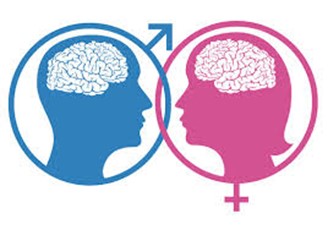Men and women are fundamentally different in many ways especially in the way that we think; Structurally our brains are different but not hugely, so why is it that the way that we think and consequently communicate is so different?
Brain structure and processing – men vs women.
Men on average have a 10% larger brain by volume. But, women have about 15-30% thicker cortical grey matter – and that’s the good stuff. That’s the stuff which does the thinking. Whilst men have larger brains so you would think they have higher IQ’s, they don’t, and this may be due to the fact that women have thicker grey matter, so they have more neurons and therefore there is no difference in IQ’s.
Studies also show that men mostly use their brain’s left hemisphere to process information, while women are more skilled at using both hemispheres. Generally, women are able to multi-task and process information quicker than men making them better in the language department; but men tend to be more logical and rational deeply engaging in one task rather than several. Men are more likely to be dyslexic or have other language disabilities, since they’re more often left-brain dominant and are also more prone to autism, ADHD and Tourette’s Syndrome, whilst women are more susceptible to mood disorders such as anxiety and depression.
Women have a larger hippocampus, our human memory center, with a higher density of neural connections. As a result, women tend to input or absorb more sensorial and emotive information than men do. Women’s brains also have a higher degree of blood flow going to the cingulate gyrus (a part of the brain involving concentration), this could explain why women will focus on and revisit emotional memories more than men. Men in general tend to reflect more briefly on an emotive memory, and then move on, many men will choose to do something active and unrelated to feelings rather than to analyse their feelings at all.
Hormones also have a large role to play in the differences in how men and women think. Both males and females release the hormone oxytocin during stressful events. But female oestrogen combines with oxytocin to produce a calming effect, whereas male testosterone only makes men more aggressive. The brain areas that control aggression and anger are larger in women than in men, which may account for some degree in larger male rates of violence.
So how and why do we communicate SO differently?
Why talk?
He believes communication should have a clear purpose, there is a problem that needs solving or a point to be made and talking is used to get to the root of the dilemma as efficiently as possible.
She uses communication to put across how she is feeling and what it is she wants to say. She is sharing and releasing negative feelings.
Talk more or less?
He prioritizes productivity and efficiency in his daily life, and conversation is no exception. When he tells a story, he is straight to the point sharing only those details that are essential.
She uses communication to explore and organize her thoughts. She may not know what information is necessary until the words come spilling out. A woman isn’t necessarily searching for a solution when she initiates a conversation, she’s looking for someone to listen to and understand her feelings. Psychology Today, notes that while women speak around 250 words a minute on average, men clock in around half of that, at 125!
Verbal or Non-verbal?
He prefers to stand shoulder-to-shoulder at an angle, so that he can keep an eye on who he’s talking to but also the room in general, and tends to be more guarded with facial expressions and other non-verbal forms of communication.
She relies heavily on various forms of non-verbal communication, such as nodding, eye contact and facial expressions preferring to communicate sitting down or standing with others in positions where they are able to talk face-to-face.
When she needs to talk
He will want to tackle her problems head on, he will be impatient to solve the problem as quickly as possible. Because he wants to ‘fix’ the problem so badly, he may not listen properly or he may take what she says literally, taking her mood personally and defending himself, exasperating the problem.
She uses words as tools to explore and express her difficult emotions when she is upset, she is able to process her negative emotions and let them go. She values support and nurture, and is most fulfilled by sharing.
When he needs to talk
He will instead, often withdraw when he’s upset or stressed, avoiding communication. He reduces stress by forgetting about his problems and focusing on other things like watching television, reading the newspaper, or Physical activities.
She might interpret her spouse’s silence as a sign that she is failing him or that she’s losing him. She instinctively tries to nurture him through his problems by asking an abundance of caring questions. Or she may react defensively out of fear that her own need for healthy open communication is not being respected within the relationship.
Understanding how men and women differ when it comes to talking gives everyone a little more empathy when it comes to discussing other issues. And understanding one another is a big step when it comes to building and maintaining a good relationship. In short, when men and women both appreciate the innate differences in the way they communicate, they can look for ways to help balance their issues out and find a sort of common ground that will allow them to take into consideration — and possibly discover a way around them.
Below are just a few gender communication strategies to think about:
- Take these facts with a grain of salt – It’s important not to use this information to stereotype all men or all women. Of course, not everyone fits these generalizations. Some of these behaviors are based on acculturation and learning and some of them are based on how our brains work.
- Stay aware – Both men and women need to be aware of each other’s styles of communication both verbal and non-verbal in order to avoid miscommunication and work better together.
- Be as clear, specific and brief as possible
- Listen and how validation and confirmation of how he/she feels
- Recognize that many different styles of leadership can be effective.
- Men, make room for the contributions of women. When asked for a decision by a woman or for your opinion if you are an internal processor, let her know you are in process of thinking about it so she knows she is heard.
- Women, get comfortable asserting more space for yourself. When dealing with men in decision making, try to stop yourself from processing out loud. If you do process out loud, let the man know that this is a process you use for decision making and you are not asking him what to do.
- Learn about male and female styles of communication and be able to use both. You need both to deal with the complexity and diversity of situations in today’s world both personally and professionally.


0 Comments